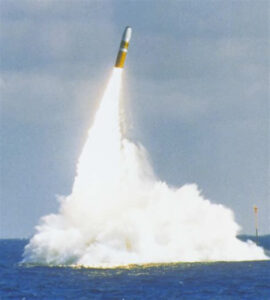
The UK has been a nuclear weapon state since 1952. It is one of the five officially recognised nuclear states under the Nuclear Non-Proliferation Treaty (NPT). The UK adopts a posture of minimal credible nuclear deterrence, assigned to the defence of NATO. The UK does not have a policy of ‘no-first use’.
Position on Disarmament
Since the end of the Cold War, the UK has taken a number of disarmament steps in support of the NPT. It has withdrawn all other nuclear weapons systems except for its submarine-launched Trident system. It has made changes to the operational status of the deterrent and had been increasingly transparent about its nuclear inventory.
UK Nuclear Stockpile and Systems
Currently the UK has a stockpile of approximately 225 nuclear warheads, 120 are operational at any one time. Trident was acquired by Margaret Thatcher’s Conservative government in the early 1980s, to replace the Polaris missile system the UK had had since the 1960s
The Trident missile system comprises four Vanguard class submarines, three of which are normally armed. At least one submarine is always at sea on deterrence patrol. Each armed submarine carries eight US-built Trident D5 missiles. Each missile has up to 5 warheads, each warhead is around 8 times as destructive as the bomb that flattened Hiroshima in 1945, killing 140,000 civilians. If one submarine fires all its missiles, which it is designed to do, 1 x 8 x 8 x 140,000 = 45 million dead.
The warheads are manufactured and serviced at two sites in Berkshire, Aldermaston, which includes research into warhead design and the manufacture of plutonium components, and at Burghfield where the warheads are assembled and disassembled. They are routinely transported on public roads between HM Clyde Naval Base at Faslane, 25 miles from Glasgow, Scotland’s largest city, to these sites in Berkshire. The nuclear warheads are stored at the Coulport armaments depot on Loch Long, close to Faslane.
Increase in Nuclear Warheads and the Nuclear Non-Proliferation Treaty
In the 2010 National Security Strategy and Strategic Defence and Security Review (SDSR), the David Cameron government pledged to reduce the UK’s overall nuclear weapon stockpile to no more than 180 warheads by the mid-2020s. This was a 65% reduction in the size of its overall nuclear stockpile since the height of the Cold War.
However, in March 2021 the UK government shocked nuclear observers by announcing it will increase the cap on its overall nuclear weapon stockpile from “not more than 180 by the mid 2020s” to “no more than 260 warheads” – a 44% increase from the previous target. This decision represents a significant shift from the previous domestic cross-party consensus on reducing the number of nuclear weapons. In another surprise move, the UK government also announced it will no longer publish details of its nuclear stockpile and missile numbers.
This came just months before the Nuclear Non-Proliferation Treaty (NPT) Review Conference in August 2021, these announcements have major negative implications for global perceptions of the UK’s commitment to the NPT, nuclear reductions, and transparency. They also present a significant complication for the Biden Administration’s nuclear policy agenda, which aims to reduce the role of nuclear weapons in national security strategy and work with allies to move toward a declaratory policy stating that the sole purpose of nuclear weapons is to deter (or retaliate against) nuclear attacks.
Replacing Vanguards with Dreadnought
The UK is building four Dreadnought class nuclear-missile-launcher submarines (SSBN) to replace its Vanguard class SSBNs, following a July 2016 vote in the House of Commons. Construction of the third new SSBN began in February 2023. The first Dreadnought submarine is expected to come into service in the early 2030s and to be retired in the 2060s. The Core Production Capability is being built by Rolls-Royce to deliver the reactor cores for Dreadnought submarines. This project has, for the second year running, been rated as ‘red’ by the Infrastructure and Projects Authority, meaning that ‘successful delivery of the project appears to be unachievable’. Construction delays on the Dreadnought SSBN programme may disrupt the UK’s ability to maintain continuous-at-sea-deterrence (CASD) in the 2030s if the required number of submarines are not ready for service. In addition, CASD may be at risk if one or more of the ageing Vanguard SSBNs unexpectedly require repair.
Current Estimated Cost of Replacing UK Nuclear Weapon System
The total cost of replacing the UK’s nuclear weapon system between 2019 and 2070 has been estimated to be at least £172bn. This figure includes: i) the cost of replacing the four main parts of the programme (submarine, missile, warhead, and associated infrastructure) ii) ongoing maintenance and in-service costs iii) some support costs e.g. from the Astute attack submarine programme. Many projects within the UK’s nuclear weapons programme have gone vastly over their original budgets; £15 – 20 billion. New funding is being poured in to meet project cost increases. The programme is also facing severe delays, raising questions about the UK’s ability to produce this weapons system.
Development of New Nuclear Warheads
The UK is also developing a new nuclear warhead which will be carried by Trident missiles. The UK’s warhead programme, which has entered its ‘concept’ phase, will run parallel to the USA’s new W93 Trident warhead development programme. The UK Government has not provided an official cost estimate and timetable for the project, but the warhead is likely to come into service during the late 2030s or early 2040s.
Is the UK Nuclear Weapon System Independent?
When is an independent nuclear deterrent not an independent nuclear deterrent? When the maintenance, design, and testing of UK submarines depend on Washington, and when the nuclear missiles aboard them are on lease from the USA. The UK does not own its Trident missiles, but rather leases them from the United States, but these are fitted with a UK warhead. British subs must regularly visit the US Navy’s base at King’s Bay, Georgia, for maintenance or re-arming. And since Britain has no test site of its own, it tries out its weapons under US supervision at Cape Canaveral, off the Florida coast. The USA has the ability to deny access to GPS (as well as weather and gravitational data) at any time, rendering that form of navigation and targeting useless if the UK were to launch without US approval.
Sources
- British Pugwash: https://britishpugwash.org/new-briefing-aspects-of-uk-nuclear-weapons-possession/
- Nuclear Information Service: https://www.nuclearinfo.org/comment/2022/06/an-update-on-uk-nuclear-weapons-modernisation/
- Arms Control Association: https://www.armscontrol.org/act/2021-04/news/uk-increase-cap-nuclear-warhead-stockpile
- Nuclear Threat Initiative: https://www.nti.org/atomic-pulse/reversing-course-the-uks-decision-to-increase-the-cap-on-nuclear-warheads/
- House of Commons Library: https://commonslibrary.parliament.uk/
- BBC News February 2024: https://www.bbc.co.uk/news/uk-68357294
- Politico: https://www.politico.com
- CND: https://cnduk.org/
- Janet Fenton from ‘Assuring destruction Forever: https://www.banthebomb.org/wp-content/uploads/2021/07/2020-05-Assuring-Destruction-Forever.pdf
